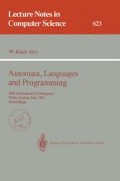Abstract
Our aim is to extend the semantic theory of elementary net systems [NRT1,NRT2] to general Petri nets. In doing so, we expect to obtain a theory which would reflect our intuition that general Petri nets are more expressive than elementary net systems (and for that matter, 1-safe Petri nets). As a first step, we provide a semantics for Petri nets using the theory of trace languages due to Mazurkiewicz [Ma]. It turns out that in order to adequately treat the multiplicity of tokens in a Petri net, we must generalize the classical notions underlying trace languages along a number of directions. After doing so, it is easy to associate such a generalized trace language with each Petri net. We then characterize the class of trace languages — called PN-trace languages — that arise in this fashion. It turns out that the new trace languages can also be used to capture the behaviours of other models of concurrency. In particular, we characterize the general event structures of Winskel [W] and their stable subclass in terms of our trace languages. One pleasant consequence of our results is that in this framework, 1-safe Petri nets, event structures, and general Petri nets constitute a strictly ascending chain in terms of expressive power.
Preview
Unable to display preview. Download preview PDF.
References
Best, E., and Devillers, R., (1987), Sequential and concurrent behaviour in Petri net theory, Theoretical Computer Science 55, 87–136.
Best, E., and Fernández C., C., (1988), Nonsequential processes, EATCS Monographs on Theoretical Computer Science Vol. 13, Springer Verlag.
Degano, P., Meseguer, J., and Montanari, U., (1989), Axiomatizing net computations and processes, In Proc. Logic in Computer Science, 175–185.
Ehrenfeucht, A., and Rozenberg, G., (1990), Partial 2-structures; part II: state spaces of concurrent systems, Acta Informatica, v. 27, 348–368.
Engelfriet, J., (1991), Branching processes of Petri nets, Acta Informatica, v.28, 575–591.
Goltz, U., and Mycroft, A., (1984), On the relationship of CCS and Petri nets, Lecture Notes in Computer Science 172, 196–208.
Goltz, U., and Reisig, W., (1983), The non-sequential behaviour of Petri nets, Information and Control 57, 125–147.
Goltz, U., and Reisig, W., (1985), CSP-programs as nets with individual tokens, Lecture Notes in Computer Science 188, 169–196.
Hoogers, P.W., Kleijn, H.C.M., and Thiagarajan, P.S., (1992), A trace semantics for Petri nets, Leiden University Techn. Rep. 92-03.
Mazurkiewicz, A., Trace theory, (1987), Lecture Notes in Computer Science 255, 279–324.
Mukund, M., (1991), A transition system characterization of Petri nets, Report TCS-91-02, School of Mathematics, SPIC Science Foundation, Madras, India.
Nielsen, M., Plotkin, G., and Winskel, G., (1981), Petri nets, event structures and domains, part I, Theoretical Computer Science 13, 85–108.
Nielsen, M., Rozenberg, G., and Thiagarajan, P.S., (1990), Behavioural notions for elementary net systems, Distributed Computing 4, 45–57.
Nielsen, M., Rozenberg, G., and Thiagarajan, P.S., (1990), Elementary transition systems, DAIMI-PB 310, Aarhus University, to appear in Theoretical Computer Science.
Pratt, V.R., (1991), Modelling concurrency with geometry, In Proc. 18th Ann. ACM Symposium on Principles of Programming Languages, 311–322.
Winskel, G., (1987), Event structures, Lecture Notes in Computer Science 255, 325–392.
Author information
Authors and Affiliations
Editor information
Rights and permissions
Copyright information
© 1992 Springer-Verlag Berlin Heidelberg
About this paper
Cite this paper
Hoogers, P.W., Kleijn, H.C.M., Thiagarajan, P.S. (1992). A trace semantics for Petri Nets. In: Kuich, W. (eds) Automata, Languages and Programming. ICALP 1992. Lecture Notes in Computer Science, vol 623. Springer, Berlin, Heidelberg. https://doi.org/10.1007/3-540-55719-9_107
Download citation
DOI: https://doi.org/10.1007/3-540-55719-9_107
Published:
Publisher Name: Springer, Berlin, Heidelberg
Print ISBN: 978-3-540-55719-7
Online ISBN: 978-3-540-47278-0
eBook Packages: Springer Book Archive

